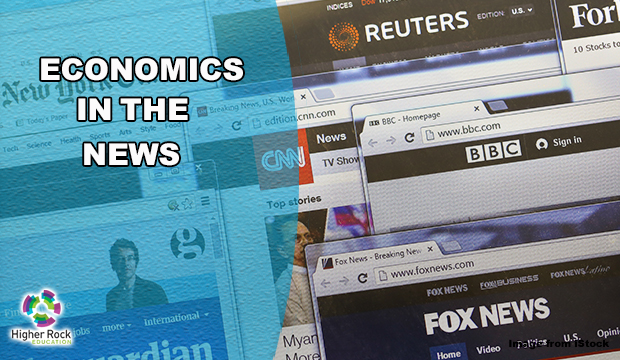Economics in the News – March 14-20, 2022
Economics impacts our lives every day. Below are some of the top storylines from this past week related to economics.
- Residential rents increased last year by 15 percent – nearly double the overall inflation rate. Tenants often have to spend as much as half of their total income on rent. According to real estate experts, fewer homes were built in the 2010s than in any other decade since the 1960s. Construction on new housing came to a halt following the housing crisis of 2008 and 2009, never fully recovering. At the same time, the millennial generation – the largest generation – are entering into the home-buying age.
Investors have also played a role, with big investment companies buying starter homes on the market and renting them out. Those companies put would-be first-time homebuyers at a disadvantage because they are able to have an all-cash offer accepted quickly, often without ever seeing the house. [60 Minutes]
- The war in Ukraine is posing a dilemma for central banks around the world. Experts say that the war has increased the uncertainty they face to rein in price increases without damaging the recovery from the pandemic. Many major central banks have moved decisively against inflation with decisions to tighten monetary policy. But the war in Ukraine is likely to slow global economic growth by at least one percentage point this year while increasing inflation by 2.5 percent, according to the Organization for Economic Cooperation and Development.
Last Wednesday, the Federal Reserve raised interest rates by a quarter-point. It was the first of seven anticipated increases throughout 2022, after inflation hit a 40-year high of 7.9 percent in February. The Bank of England raised interest rates for the third time in as many meetings on Thursday, saying that inflation could rise above 8 percent this year. Decision-makers in Europe face a difficult choice, given the continent’s proximity to the war and its substantial reliance on expensive energy. [The Wall Street Journal]
- Gig workers for ride-hailing services or delivery companies, such as Uber, Lyft and DoorDash, have been hit hard by rising gas prices. Some drivers say that they find it difficult to justify spending hours on the road driving. Because the drivers are contract workers, the companies do not reimburse them for the cost of gas.
However, Uber, Lyft and DoorDash maintain that their overall driver numbers are not down. Uber maintains that they have more active drivers now than they did in January. In order to assist the drivers, Uber and Lyft announced an increase in the price for rides in most places for at least the next two months. DoorDash, meanwhile, has announced a gas rewards program for their drivers. Those who use a prepaid debit card designed for DoorDash workers will get 10 percent cash back at gas stations. [The New York Times]
- The war in Ukraine and a coronavirus outbreak in China have posed new challenges to global supply chains. Financial sanctions placed on Russia and the closure of Russian airspace are forcing cargo planes to fly longer, more expensive routes from Asia to Europe. In addition, ocean carriers and truckers are faced with higher fuel costs. Meanwhile, dozens of Chinese factories and ports were impacted due to China’s worst coronavirus outbreak since the original surge in Wuhan.
Supply chain specialists expect conditions to deteriorate but the disruptions so far are not to the extreme as the pandemic’s worst months. Major cargo carriers have stopped accepting new shipments to Russia, Ukraine or Belarus. Goods that have traditionally been shipped throughout Europe by rail, now have to be shipped either by ship or by plane. China imposed coronavirus restrictions on more than 50 million people throughout its manufacturing heartland, affecting the areas that account for three-fourths of China’s exports. [The Washington Post]
- The NCAA Men’s Basketball Championship, otherwise known as March Madness, earns the NCAA nearly $1 billion on an annual basis. This year, the student-athletes who play the games can capitalize off their popularity. It marks the first time in the history of March Madness that players can sign endorsement deals for the use of their name, image and likeness (NIL).
According to Front Office Sports and Opendorse, brands are expected to spend close to $600 million on NIL deals by July, the first anniversary of the NCAA policy change. While the new landscape has been predictably lucrative for football and men’s basketball stars, in many cases female athletes have outearned their male counterparts. As of the end of February, women’s basketball players accounted for close to 20 percent of all endorsement deals, the second most of all college sports. Brands are targeting female athletes because of their following on social media, and to make inroads with a target audience. [NPR]
